Dawn Blazeley
Statement:
(These drawings are) a representation of the Bass Strait Islands, the sea kelp, the landscape, the flora and fauna and their connection to indigenous culture. Some are of the objects I have seen and some are the experience of walking along the beach and the feelings invoked by my surroundings.
Biographical Information:
Growing up as a young girl on both Flinders Island and the Cape Barren Island, my lifestyle was different to what it is today. My upbringing was poor at the time as a result of living on a reserve on Cape Barren Island – of the reserve at daybreak and back on at sunset. In this time we gathered our cultural foods: plants from the land and food from the sea, also collected kelp to make water carriers.
From my memory of collecting the kelp to make water carriers, I have designed my own images into my paintings. As an Aboriginal woman my paintings have created to me, my past and present lifestyle, the brightness of my dreams. I have used representation of mother earth which everyday I walk on, remembering my ancestors – how they felt when they walked on the land like I am walking today.
Patsy Cameron
Statement:
‘It makes my heart sing when I complete each beautiful basket. I think the old women would be pleased.’
Biographical Information:
Patsy Cameron, born 1947, grew up on Flinders Island and now lives at leengtenner (Tomahawk) on her ancestral lands that overlook Bass Strait in the far northeast of Tasmania.
Patsy began weaving small sample mats, following the traditional weaving technique and using white flag iris collected around Sundown Point on the northwest coast, in the 1990’s. Patsy’s first baskets were embellished with maireener shells and feathers and she returns to using shells, feathers and porcupine quills when she is inspired to bring a cultural vibrancy to her baskets.
Patsy collects materials in the northeast region of Tasmania, preferring white flag iris and lagoon grass fibres for baskets and stringybark and lagoon grass for string making. Patsy is inspired to continue to develop her work to perfect the traditional baskets and to actively pass on the unique practise to the next generation of Tasmanian Aboriginal women weavers.
Aunty Bernice ‘Bea’ Condie
Statement:
moekatan gets her ideas for patterns from the nature of the sea, the living sea shells which she uses and their life cycles and patterns of survival.
Biographical Information:
moekatan is a palawa woman; her name means ‘of the sea’. Her Australian name is Bernice Condie. She is a direct descendant of manalagena, bangana of the trawulwai Nation. Her Spirit is linked to her Country, tebrikuna, now commonly known as the northeast region of Tasmania, and to the great stretch of water that is known as Bass Strait.
She was born in Launceston, Tasmania in October of 1936. She is the fourth sibling of thirteen, having grown up at Lady Barron, Flinders Island, looking across Franklin Sounds to the islands where the palawa tradition of muttonbirding has been carried out since the early 1800s. Her father was a fisherman and moekatan grew up playing and then later working near or on the sea.
As a child she was taught her culture and history; who she was, where she came from, and what was culturally and spiritually important, by her extended family, her Elders and her Community. An essential aspect of that was learning the skill of ‘maireener’ shell necklace making – a tradition which is at least 20,000 years old. Her Auntie Louie Brown taught her the intricacies of finding the live shells, cleansing through ancient ritual and natural processes, sorting, and designs – what belonged to which family and individual. She learned where to look for and find her own shells, the detailed and intricate stringing practices and the oral histories associated with this ancient and very precious cultural art. There are only seven practitioners of ‘maireener’ in the world and she feels privileged and proud to be one of them. moekatan works with some of the rarest shells. She says, “I work with pride to honour the memories of the old ladies who taught me – they give me the strength to continue and their Spirits guide me in teaching others.”
She is the only member of her family to continue this ancient expression, however her younger sister, maikutena, expressed interest in learning and moekatan commenced teaching her. moekatan considers her role as a teacher, responsible to pass on this cultural knowledge to the younger people of her extended family, as an honour. She says there is nothing more honourable than being trusted by her Ancestors to ensure precious ancient Knowledges are continued through millennia.
moekatan only re-established herself as a practitioner of maireenier in her later years after retiring from employment, however she has been widely exhibited and acknowledged by her peers and contemporaries as a quality practitioner. She has also been featured in publications and television because of her passion, professionalism and integrity as a matriarch of palawa and the practice of ‘maireener’.
She says she listens to the sounds of the sea and wind and sees the visual patterns in her spiritual dimension. moekatan says the sun reflecting on the colours of the shells she uses represents the ebb and flow of the seas as the tide rises and falls. She has always been fascinated that, no matter where she is, by holding a shell to her ear she can hear the waters communicate with her. She finds working on these precious cultural products is a time of spiritual connection with the sea, after whom she has been named and by whom she has lived most of her life. The sea has nurtured her Spirit and her body. moekatan believes the sea brings her peace and tranquility and she tries to honour that by relaying it through her work.
moekatan also paints landscapes. She does these only for specific people and tries to connect with that person through her interpretation of their Spirit, personality and life passions. moekatan has never exhibited these expressions because they are painted for the one person only and, once finished, are given to the person intended.
moekatan’s third artistic expression is seaweed art. She collects seaweed sometimes as she is collecting shells and other times when she feels at one with the sea. She cleanses the seaweed and arranges it in patterns to dry to demonstrate the beauty of the seaweed itself and it’s natural movement in the tidal ebb and flow of the sea. These are then framed. These also have not been exhibited to date.
‘Bernice Condie’ by Vicky Matson-Green, Dictionary of Australian Artists Online http://daao.org.au/main/read/7485
DAAO terms of use http://daao.org.au/legal/eula.html
Audrey Frost
Statement:
Following a series of work I made using the coiling technique which is developed by wrapping and stitching the plant fibres. This method has encouraged me extend my skills into new work focusing on the twining technique for this mat. Twinning holds a significant cultural value in my baskets as it is the technique used by our ancestors, who used this method in Tasmania in their traditional baskets. My work reflects an historical connection to the past while incorporating my current interest and my future to maintaining my cultural practice.
As an elder I am keen to pass on my experiences of skills and knowledge to my family and younger generation in the community to maintain our heritage.
Biographical information:
Audrey Frost was born on Cape Barren Island where she attended school until her family moved to live on Flinders Island.
Audrey is textile fibre artist who uses different materials to develop her work within the Aboriginal community for cultural programs, assisting young women in traditional craft practice. Audrey completed her Associate Diploma of Fine Arts at the School of Art, University of Tasmania in 1993. Her woven baskets have been exhibited in a number of exhibitions including one which travelled to Asia in 1995.
Audrey created a range of collecting baskets for the tayenebe exhibition using a range of fibres including Sweet Rush plant collected at Binalong Bay on the east of Tasmania. The Collecting baskets references women’s traditional culture to gather many objects in the collecting process such as shells, berries and ochre.
Audrey’s fibre work is held in collections at the Curtain University, Perth, Western Australia and the Tasmanian Museum and Art Gallery collections.
Aunty Corrie Fullard
Statement:
Making shell necklaces is a traditional cultural practice passed down from mother to daughter through generations of Tasmanian Aboriginal women.
Tasmanian Aboriginal women traditionally crafted theses necklaces to wear on special occasions and to trade with other tribes for items such as ochre and tools. Many traditional necklaces were traded or given to early explorers and made their way into many private collections which were later donated to museums around the world.
Biographical information:
Corrie Fullard is a Tasmanian Aboriginal Elder and shell necklace stringer born and raised on Flinders Island where making shell necklaces was an important cultural practice that her family continued.
Corrie grew up helping her parents and other family members collect the beautiful shells required to make these necklaces.
For the last thirty years Corrie has continued to collect shells and make necklaces to keep the cultural practice alive and it also helps her relax and remain healthy.
In her retirement Corrie has had more time to make her shell necklaces and teach her daughter Jeanette the finer art of stringing. Mother and daughter regularly travel to Flinders Island and other parts of Tasmania exploring beaches for these special shells.
Corrie is a well known and respected Elder and shell necklace stringer. Many of her traditional shell necklaces are held in museums and private collections in Australia and around the world.
Her necklaces have been acquired by the Queen Victoria Museum in Launceston, Hobart Museum and Art Gallery, National Gallery Canberra and private collectors in Italy and USA.
Aunty Dulcie Greeno
Biographical Information:
Dulcie Greeno is one of Tasmania’s longest practising Tasmanian Aboriginal shell necklace makers. Born on Cape Barren Island in 1923, ‘Aunty’ Dulcie currently lives in Launceston and returns to the Furneaux Islands to collect shells biennially. She has been making for almost 40 years.
Her work has been exhibited widely including an international exhibition developed between the National Museum of Australia in 2002, Stories from Australia and the Guangzhou Museum of Art in China. Her traditional shell necklaces can also be seen at Tasmanian Museum and Art Gallery and Queen Victoria Museum and Art Gallery in the permanent ‘Strings Across Time’ exhibition. Her work is also included in numerous private and public collections Australia-wide.
Rex Greeno
Statement:
This canoe has been specially crafted for the rrala manta manta exhibition at the Design Centre – Tasmania during the Regional Arts Conference, Junction 2010.
Biographical Information:
Rex was born on Flinders Island. From an early age he became involved in a number of cultural practices including mutton birding, making snares to trap kangaroos, learning all the elements to catching crayfish and scale fish with his grand father Silas. After Rex left school he became a deck hand for his father. At the same time he continued working closely with his brother Bruce that lead him to work as commercial fisherman spanning almost 40 years in the industry.
Growing up on the Flinders Island enabled Rex and his family ideal opportunity to spend a great deal of time traveling around the Furneaux Islands by sea.
Since retiring, Rex has used his sea experience as an inspiration to build a paper bark canoes.
In March 2010 Rex and his son Dean spent time collecting and building a bark canoe to ensure the making processes will be passed onto grandson, Harrison.
Jeannette James
Statement:
My mother, Aboriginal elder, Corrie Fullard, was taught this skill by her parents and has ensured this practice continues by teaching me the skill of collecting, cleaning and making shell necklaces. We travel extensively around Tasmania and the Bass Strait Islands to source their shells. The collecting and cleaning process can take up to 8 months before the shells are ready to be made into wearable jewellery.
Recently I have started to use echidna quills in my traditional and contemporary jewellery. I find them to be an interesting but challenging medium.
Biographical Information:
Jeanette James is a Tasmanian aboriginal artist who grew up with her mother, Aboriginal artist Corrie Fullard, in northern Tasmania. She spent her early years walking the beaches of the island collecting shells. Later the family ran a fishing business, and Jeanette first got to know “mainland” Tasmania from the sea.
Jeanette continues the age old tradition of shell necklace stringing as it is passed on by her family. It is a practice that has continued for generations.
Whilst Jeanette began working in shells, she has extended her repertoire to include echidna quills strung on fibre.
A highlight of her career was winning the Wanjunk Marika award at the 2000 National Telstra Aboriginal and Torres Strait Islander Art Awards, an annual award held in Darwin.
Her exquisite necklaces have been exhibited throughout Australia and her work has been acquired by Queensland Museum and Art Gallery, Darwin Museum, South Australia Museum and Art Gallery and the National Museum in Canberra and exhibited internationally in Singapore and Alaska.
Vicki Matson-Green
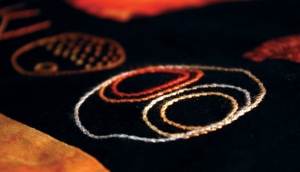
Quilt,2010, Various cotton materials, quilting cotton, embroidery thread, fabric paint, wool/cotton wadding, 243x243cm
Statement:
Quilt Story: This hand stitched quilt was made with a great deal of love and is for my daughter, Tarni. It portrays the Creation of Fire from peirabeena (North East Tasmania). It tells the legend that Fire was created by Lightning originating in the Milky Way – the place from where the Ancestors walked across the Stars and onto the Land. In addition it links Tarni and her children to her familial heritage through her father and I.
Middle piece: This section has the Moon (Mother) as its centre. The Moon dictates the moon-time of the female and is a strong symbol of female fertility and hence within this story represents the womb and symbolises the genetic ties to our Ancestors through our family trees. Within this symbolic womb sits my daughter, Tarni and her sons – Jhdara and Leiwyn. The trees surrounding the Moon are directly linked to Tarni’s heritage through her father and I. Central to that is the Peppermint Gum which manalagena considered his kin. The lightning strike splits the Peppermint Gum and creates the first Fire. Represented on the branches of the Peppermint Gum are Tarni’s family – her Father & I, her brother Jason and his children Kirra-dhe and Aidan, and her paternal and maternal grandparents’ families with linkages through to manalagena.
Clockwise from there is the Silver Birch, a native of Scotland, and is a direct tie to the Armstrong line through Tarni’s maternal grandfather.
The next family tree is linked to Tarni’s Father’s heritage from Mauritius and is the native Calvaria Tree which has almost become extinct. The fertilisation of the Clavaria required the Dodo’s digestive tract to assist with germination. Since the extinction of the Dodo the seeding of the Calvaria has become very rare.
The following tree linage symbolises Tarni’s Japanese heritage through her paternal Grandfather and is the Sakura, a native of Japan. As the population in Japan increases the Sakura becomes more rare and is greatly revered.
Finally the Flowering Gum is from the Country of the Bunarong Nation which is part of Tarni’s maternal Great-Great Grandmother’s line through her Grandfather. Each Gum is explosive and is designed to assist with Fire, and hence fertilisation of other trees, through the Eucalyptus oil contained in its leaves.
External Blocks and Patterns: The black band around the centre piece with the embroidered and glass stars represents the Milky Way.
The blocks surrounding the centre piece symbolise the importance of Fire to fertility within the Legend of Fire. There is a continuum of barren soil, followed by the beginning of fire, the power of fire, and the fertilisation of growth and greening of the Land.
Surrounding those blocks is the hand embroidered petroglyphs (rock art) which was so painstakingly etched in rock and told the stories of our Ancestors; their connections to the Milky Way, the Moon (Mother) and the Sun (Father); the Scared Land and the animals; and Waterways and fish.
Finally, the external panel consists of black foot prints symbolizing the Ancient Pathways of our Ancestors and the Aboriginal People of Tasmania who follow in their footsteps.
Biographical Information:
Vicki maikutena Matson-Green comes from Flinders Island. Her parents were from the Cape Barren Island Aboriginal Reserve and later moved to Flinders Island with their 13 children. Vicki worked at the Flinders Island Aboriginal Association from 1980–85 as secretary and then manager, where she became passionate about Aboriginal issues.
Vicki and husband Chris moved to Launceston in 1987 to enable their children to complete college and Vicki to attend university. Vicki dedicated almost twelve years helping establish Riawunna, Centre of Aboriginal Studies at the University of Tasmania, and to progressing Aboriginal higher education. During this period Vicki began learning about unknown aspects of her Aboriginal history while maintaining and teaching her cultural knowledge to others. Vicki became a published Aboriginal historian while at Riawunna.
In her work Vicki acknowledges those before her and is committed to teaching others in the future.
Len Maynard:
Statement:
“I want to tell the story of our Aboriginal history. I don’t think many non-Aboriginal Tasmanians know many of the terrible things that happened to our people. I hope that through my artwork I can help people understand more about our past.”
Biographical Information:
Len was born in Launceston in 1946 and was a late inductee to the art world.
Len’s Aboriginal lineage descending from his father’s family was something he was always aware of. However, Len’s father, a returned serviceman from WW1, suffered ongoing illnesses as a result of his service in the armed forces. Due to this, Len’s Aboriginal heritage was something that had remained mostly unexplored between father and son..
In 1994 Len undertook a Bachelor of Fine Arts and in 1999 completed his Masters degree in Fine Arts and Design; an achievement of special pride as he had little formal education as a child.
Over the years Len compiled a collection of reference material about Aboriginal culture and history. His Aboriginality, in a way, became self-taught. Spending a good deal of time drawing reference from Aboriginal culture and history, he now draws on these stories and retells them through his art.
Still practicing in Launceston, Len has exhibited nation-wide. His work is contained in collections at the National Gallery of Australia and private collections throughout the country.
Colleen Mundy
Statement:
Colleen says her son is an inspiration with his love of the land and his knowledge of Tasmanian Aboriginal Culture and History. She’s proud to be a keeper of Traditional Tasmanian Aboriginal basket weaving.
Biographical Information:
Pinterrairer and Parperloihener woman Colleen minungkana Mundy was born at home in South Eastern Tasmania in 1940. The eldest of a family of five, she has two brothers and two sisters. Colleen’s mother Joyce Honner was from the Central Highlands of Tasmania. Colleen’s father Bert Mundy was from Nicholls Rivulet near Oyster Cove in the South East.
Colleen says “My Father, my Grandmother and my Great Grandfather were all born at Nicholls Rivulet. Tanganutara and Nicermenic had eleven Grandchildren and they were all born at Nicholls Rivulet and many of them raised large families there. Our families formed the Aboriginal Community of Nicholls Rivulet. Everyone looked after each other and shared what they had…”
Spending much of her adult life in the bush, living off the land, Colleen used plants and lichens to make bush dye. She goes to many places around Tasmania sometimes in remote areas by the sea and in the bush collecting Native plant fibres for weaving often taking her tent and camping out. Colleen has fond memories of a childhood spent camped by the sea with her parents.
“ I remember when I was a little girl being rowed across the bay by my father in a dinghy and when I stepped onto the beach there were so many shells I couldn’t walk without treading on them!”
Colleen uses the White Flag Iris for most of her weaving and says it is a very strong fibre but at the same time the baskets feel springy and have a nice silky finish. Colleen also makes contemporary baskets decorating some with feathers, shells, fur and other things, but prefers weaving the traditional Tasmanian Aboriginal twined baskets.
“My grandmother Pearl Mundy, still had a basket that was made by her Grandmother Fanny Smith. Fanny was Grandfather Tasman’s mother. Fanny and her sister, Aunt Mary Ann, both made baskets and shell necklaces at Oyster Cove. Fanny still made baskets throughout her life at Nicholls Rivulet”
Colleen says her son is an inspiration with his love of the land and his knowledge of Tasmanian Aboriginal Culture and History. Colleen strongly supports Land Rights. She’s proud to be a keeper of Traditional Tasmanian Aboriginal basket weaving.
Leonie Dickson
Statement:
‘It gives you a good feeling to watch something grow from your own hands, to watch the fibres take shape and watch the story unfold at the end, this is my heritage, this is my Country, this is me.’
‘This piece represents the Aboriginal life. The carrier: giver of life, passer on of knowledge. It is the carrier of our culture and heritage. If we don’t carry it with us, we don’t have anything’
Biographical Information:
Leonie Dickson is a Tasmanian Aboriginal artist who is also a descendant of the Bunurong people of Victoria. Leonie was born on Flinders Island in 1950 and moved with her family to Hobart when she was six years old. She has worked in Aboriginal Affairs in a variety of roles for over 30 years and is currently the Aboriginal Health Liaison Officer at the Royal Hobart Hospital. Leonie resides in Glenorchy, where her family is actively involved in the Aboriginal community.
Leonie has experimented with different forms of art, but it was not until she was taught basket weaving and kelp work by her cousin Lennah Newson and her sister Verna Nichols that she settled with these two media. Leonie works mainly with kelp, but in the last three years has also mastered basket making with grass fibres. Her inventive work ranges from very tiny to large mixed media pieces.
Leonie has exhibited in Tasmania at the Living History Museum of Aboriginal Cultural Heritage, Moonah Arts Centre, Grand Chancellor Hotel, Women’s Karadi Aboriginal Corporation, Palawa Aboriginal Corporation, and in Victoria at Churchill Island. Leonie has participated in many workshops and her work is represented in national and international collections.
Verna Nichols:
Statement:
Contemporary Water Carrier:
The natural resin makes the kelp look fresh out of the water; still wet. Adding the shell strengthens the element of the sea.
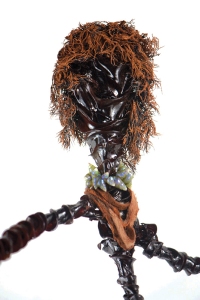
Hunter, kelp, sea weed, kangaroo skin, Huon pine, tea tree natural resin, river weed, stringing bark, ochre. 55x16 cm
The Hunter’ statue:
‘This is a contemporary depiction of a traditional Aboriginal man. Mixing traditional and contemporary materials to show how the Tasmanian Aboriginal people have been able to adapt from time beginning to now.
Bio:
Verna Nichols is a Tasmanian Aboriginal artist who is also a descendant of the Bunurong people of Victoria. She works in the media of painting, silkscreen printmaking, ceramics, drawing, weaving and kelp work. Nichols was born on the 11th August 1947 on Flinders Island, Tasmania, and spent the next seven years on the island before moving to Hobart with her family. She has also lived in Melbourne and Strahan, Tasmania but returned to Hobart in 1997 where she still resides.
She has only shown her work professionally since 1991 and Nichols’ work was recognised at a national level when in 1993 she was a finalist in the first National Aboriginal and Torres Strait Islander Heritage Art Award (latterly known as the National Indigenous Heritage Art Award), and in 2005 in the 22nd Telstra National Aboriginal and Torres Strait Islander Art Award.
Whilst Nichols has achieved national and international recognition she has not been neglected in her home state where she has worked in the Aboriginal Affairs sector most of her life. She has taught arts and crafts at numerous schools, Aboriginal school camps and festivals.
Nichols is represented in the permanent collections of the National Gallery of Australia, the National Museum of Australia, the Tasmanian Museum and Art Gallery, the Living History Museum of Aboriginal Culture, Nicholls Rivulet, the Brest Maritime Heritage Centre, the Women’s Karadi Aboriginal Corporation and the South East Tasmanian Aboriginal Corporation.
Verna Nichols and Leonie Dickson:
Nations United
The set of nine circles represent the nine Tasmanian Aboriginal nations. Contemporary and traditional materials (string and ochre) are used to connect to each circle just as the nine nations were connected to each other through trade, marriages and war.
Judith-Rose Thomas:
Statement:
As a descendent of manalargenna, Chief of the Cape Portland tribe, the painting draws deeply on my Aboriginal heritage and refers to symbolism, spiritualism and mythology within the Tasmanian Aboriginal culture, showing a relationship between the landscape and the Tasmanian Aboriginal people. The work consists of the Tasmanian Aboriginal petro glyphs, carved by the Aboriginal ancestors into the rocks in specific areas around Tasmania.
The paintings are viewed as a visual language and by isolating the work within a frame preserves the petroglyphs for future reference. By using geometrically shaped frames depict the geometrically constructed contemporary world in which the Aboriginal people now exist. Pink, blue and mauve reference the Aboriginal women depicting their femininity and fluid freedom which all Aboriginal people require, moving across the land of their ancestors.
I sometimes work with modeling compound on canvas and MDF boards using gouache paint. Although the Western art I do is done in oil on canvas, all the works have an Aboriginal reference.
Biographical Information:
Judith-Rose Thomas was born in Launceston of Aboriginal parents and has resided in Launceston most of her life and was the first Tasmanian Aboriginal artist to be selected for Tasmanian Government Art Spaces with arts@work in Hobart. Her art pieces have been places in major galleries and exhibitions around the state of Tasmania and purchased by various government departments.
Art work has also been purchased for private collection around India, England, Europe, Japan, America and Australia, including at the National Museum of Australia.
Judith-Rose graduated from the University of Tasmania is 2001 with a Bachelor of Fine Arts degree, and placed on the Dean’s Role of Excellence. After obtaining a University Bursary, she graduated again in 2002 with a Bachelor of Contemporary Arts with Honours degree. Upon receipt of a a University of Tasmania/ Riawunna Scholarship, she also completed a Masters of Fine Arts and Design in 2004.
Judith-Rose has tutored at the University of Tasmania at the Riawunna section for Aboriginal Higher Education, and has been invited to become a member of the Aboriginal Arts Advisory Group of the Tasmanian Arts Advisory Board.
Judith says ‘I had dreams and expectations from the age of 14 to attend a university, although at the time it was an unrealistic dream because it was only for the ric and those with intelligence, not me. It was these negative ideas which showed my lack of self-confidence, and it stayed with me through to adulthood. Although my life did change, it was not until I asked someone to teach me how to paint, how to do folk art, and was told that painting was not my forte and that I should stay with sewing. Determination motivated me and I found someone to teach me folk art, after six months I then became the teacher and taught for seven years. It was a great feeling of self-satisfaction to notice the confidence grow in the people I taught. After an advertisement in a country paper ‘Learn to draw and paint in oil’ with Greg Waddle at Evandale, my life changed direction. Learning to paint with Greg for approximately 18 months, created a solid foundation for me to build a future.
Being actively involved in education, my communication skills had improved to the extent it enabled me to participate in the Tasmanis Talkabout forum at the Queen Victoria Museum and Art Gallery, and curatorial session at the University of Tasmania Academy for the Arts. The Tasmania Aboriginal petroglyphs [Aboriginal rock carvings] are used in my artwork and they were also used by our Aboriginal Ancestors to educate the youth in the tribes.
Having presented numerous exhibition I find the skills of goal setting and planning has enhanced my leadership skills, helping me gain a high level of self-reliance and to chow good tean participation.
My total dedication to my career and goals does not deter me from remembering who I am and where I come from. My Aboriginality and the Aboriginal people of Tasmania are important to me and it has been a great honour to tutor at Riawunna. Two community based projects were anal Aboriginal exhibition in Hobart at the Carnegie Gallery and Tasmanian Aborignal Artist gieft card project, where proceeds went to further Aboriginal participation in the Arts. I feel a great sense of satisfaction having gained the opportunity to give back to my community.
I have been invited to become a member of the Tasmanian Aboriginal Arts Advisory Board, and was the feature artist for the Deloraine Craft Fair in 2004. By accepting the invitation I was fulfilling me commitment to my community and created opportunities to help other Aboriginal people.
It is through my art I have the opportunity to give, with donation of artwork to raise money for those less fortunate than us. I have donated to The Blind Society, Make-A-Wish Foundation and the Risdon Prison Aboriginal Trust fund, where the money raised from the artwork could possibly keep this trust fund going for an extra three years.
My exhibitions increase awareness of Aboriginal art to the communities in Tasmania and I will certainly be a catalyst for Tasmanian Aboriginals to hold more exhibition of their arts and craft. I paint as a Aboriginal to show communities the rich diversity of contemporary Aboriginal art and its significance in the context of Aboriginal art history and reflect some material aspects of the culture that have enriched the lives of Aboriginal for some 40,000 years.
The higher education I received has enabled me to support other Aboriginal people. I am so proud of being an Aboriginal person and my dream did become a reality.
Vicki West:
Hanging installation, kelp, video projection, dimensions variable
Statement:
Inner Resistance is an installation that explores aspects of the history of Aboriginal Survival and resistance to colonial invasion. Bull kelp is a sea plant that grows around rocky coastal regions of Tasmania. The kelp in this work was collected from my country in North East Tasmania.
Biographical Information:
Vicki was born in 1960 in Launceston, Tasmania, where she is still based. Vicki’s ancestral country is on the north-east coast of Tasmania. When growing up Vicki and her family lived with her maternal Grandma, who was a renowned craftswoman and shared her knowledge with the women in her family. Vicki learned basketry, knitting, sewing, macramé, rag matting, millinery, crochet and lace making as a young girl and continues to utilize these skills today.
Vicki’s journey to her current arts practice evolved from her participation in the Aboriginal Bridging Program at the University of Tasmania (UTAS) in the early 1990’s, where she joined Elders and other Tasmanian Aboriginal community members in learning textile dyeing, printing, ceramics, photography, sculpture and jewellery making.
Her interests and skills grew, inspiring Vicki to begin studies at the Tasmanian School of Art in Launceston in 1994. She completed her Bachelor of Fine Arts (First Class Honours) in 2001 and most recently, in 2008, graduated with a Masters degree in Fine Arts (UTAS).
Along with traditional skills of weaving and water carrier making that she learnt as a young woman at a Tasmanian Aboriginal cultural workshop, Vicki developed a deep understanding of the significance of her ancestors’ use of fibres and kelp for survival. She began to explore the materials, along with other local fibres such as dodda vine, in her art making, developing her own contemporary waving style.
Today, Vicki is well known for her installations and sculptural forms that bring together her years of exploration and development. Although the materials central to her art are primarily kelp and natural plant fibres, she also incorporates a range of man made materials, and draws on her various skills to express her ideas.
Her artworks vary from large scale installations to very delicate and intricate smaller works.
Vicki’s artwork is held in a number of private and public collection around Australia, and she has been commissioned for significant artworks/installations throughout her career as a professional artist.
Statement:
Inner resistance is an installation that explores aspects of the history of Aboriginal survival and resistance to colonial invasion. Bull kelp is a sea plant that grows around rocky coastal regions of Tasmania. The kelp in this work was collected from my country in North East Tasmania.
This inner cloak was created for the last instalment of a community cultural development arts strategy known as Gathering Ground at Redfern in May 2010. On this performance promonade a site known as Pemulwuy Park was used as to acknowledge and pay respect, in celebrating the life of the first Aboriginal resistance fighter of Australia, Pemulwuy. (check with lily) In this installation footage from that performance is combined with the cloak and circle forest of kelp fronds, inviting the viewer to contemplate Aboriginal cultural resilience within a 21st century context.
Bull kelp is a sea plant that grows around rocky coastal regions of Tasmania. The kelp in this work was collected from my country in North East Tasmania. Kelp is a traditional resource utilised by my ancestors to create water carriers and these were intrinsic to survival. I draw on this and the kelp for me becomes a metaphor of survival. It is an important cultural material and also under threat due to global warming, over resourced (fished – mined) and other environmental pollutants.
Over the years I have worked on numerous environmental installations, expressing my concern for the Tasmanian land/water-scape and how the environment is being damaged, changed and impacted upon by current land/water-use practices. For me this has highlighted the importance of the environment as both a source of materials and inspiration in my work.
In a time dominated by global debate over issues of climate change, it is critical that we engage with these issues on a local and regional level. We must also understand the consequences of inappropriate or disrespectful development for future generations.
Since the arrival of Europeans in Tasmania around 200 years ago, the way in which the environment is managed has changed dramatically, with land clearing, forestry, mining and industrial development all impacting negatively on this land. Over the past generation (my lifetime) this has gradually accelerated. I believe that we are now on the edge of a critical balance, and that country is being compromised by greed and power.
Our ancestors lived in unison with country, knowing that we are just one part of an interconnected and interdependent natural system and that we have an obligation to care for and protect all things that are a part of this.
Over the past 20 years I have developed the way I work with natural fibres (land – sea) drawing on past traditions, techniques and materials, I create contemporary vessels, forms and large scale installations that each carry messages of continuing cultural practice and survival.

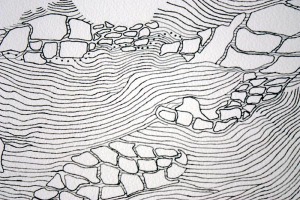
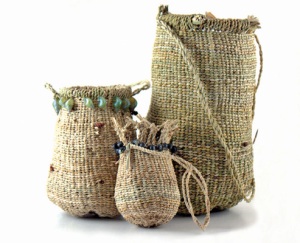
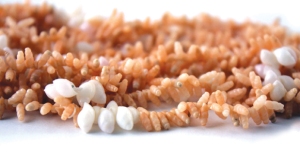
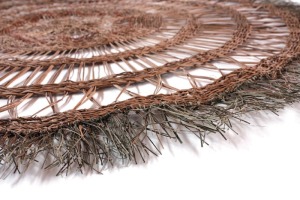
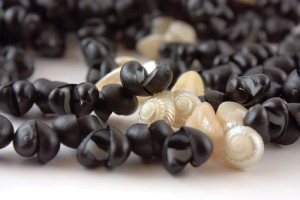
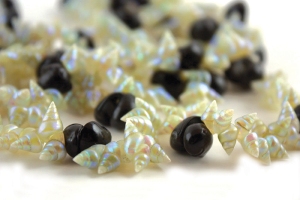
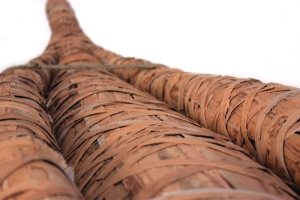

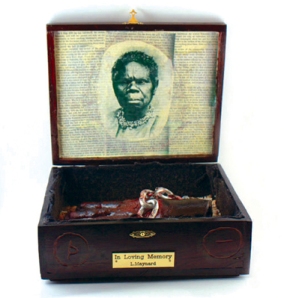
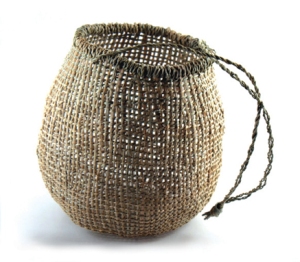

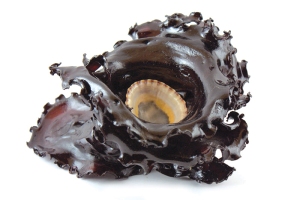

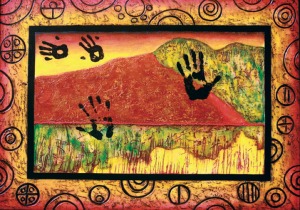

Pingback: rrala manta manta